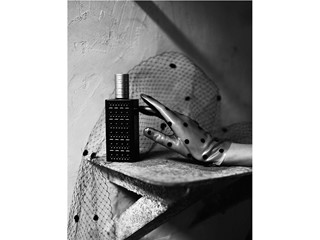Azzedine Alaïa is an anomaly in the world of fashion: while at the head of a brand that bears his name, he has engaged in an ongoing dialogue with costume history, developing and articulating a language that is uniquely his own. Alaïa’s designs are part of fashion’s lexicon – from his Bandelettes body-con dress of S/S90, to the sinuous, zipped black dress of S/S03 (his tribute to a costume worn by the French actress Arletty in the 1938 film, Hôtel du Nord) to the monochrome Houpette gown of S/S04 and his many crafted pieces in perforated leather, wool and crocodile.
The couturier’s encyclopaedic knowledge of his predecessors, famed or anonymous, is unparalleled; his ability to create something entirely new is unrivalled. Alaïa’s work carries all the signs of belonging to a specific time and place, and yet pushes the borders of what location signifies in order to create its own significance, in its own temporality. He is probably the world expert on clothing; and, at the same time, he is one of the very few to have earned the privilege of having dramatically changed costume history. This year, he released his inaugural, highly anticipated perfume, Alaïa Paris, created with the same rigour that he applies to his collections, and the same spirit of community he applies to his life, while also being the first couturier invited to present his work in Rome’s exquisite Villa Borghese museum, amongst the Berninis and the Caravaggios, for the show Couture/Sculpture (until October 25). Here, Donatien Grau questions the elusive designer on his deeply cerebral approach to clothing.
How would you connect fashion to elegance?
"Fashion is an invention; elegance is a truth. The peasant in the fields is as chic with her apron and clogs as the sophisticated woman in magazines. These are different truths, but invention does not play an equal role in both."
What is the role of history and art history in your conception of fashion?
"Fashion, for me, came from art history – art history was my interest in primary school. I was looking at painting books, and I discovered Velásquez. I kept wondering how the dress of the Meninas could stand on its own. I went to the École des Beaux Arts in Tunis to try to find the answer to that question, and Spanish painting has remained a major reference for me until now. When I saw dresses by Balenciaga and Dior, I immediately wanted to find out how they were structured. The issue of history, and art history, is one of inspiration and of practice, which is an approach I am more interested in: trying to think about how things were done, throughout history. That is, getting out of history, somehow."
Would you describe fashion as a language and a discourse, as Roland Barthes did?
"It is a language. I learned that from my encounter with Vionnet’s work, who sent people to copy the drapery of ancient Greek sculptures. I then saw similar drapery in Tunisia. Even today, I keep trying to produce free drapery. It is very difficult to master the language of clothing."
"Everything is part of my life. Everything that happens around me feeds my work. It is my break from it, and the inspiration for it." – Azzedine Alaïa
The word “intellectual” was coined in a time of great political distress. Does fashion have a political role? And in what way?
"I don’t know about fashion, but couture is of interest to an individual, and I don’t see what it has to do with politics."
How would you relate the concept of fashion to that of style?
"Cocteau used to say that fashion is what shortly becomes old-fashioned while style stays. In the accelerated rhythm of the present, people tend to mix style and the market. There has never been as much vintage as now. We look for style where we can find it – that is, in the past. But women, when they have style, never become old-fashioned."
What does fashion have to do with intellectuality?
"Fashion makes the life of intellectuals more exciting: it gives them the thrill of life, light and substance – it even provides writers with new characters. At Louise de Vilmorin’s, I met André Malraux and so many prominent writers. They were there, and they were happy to be there. It’s proof that elegant life – rather than fashion – is the spirit of an age, and therefore is likely to draw intellectuals."
You live in your time, and yet the fashion you create seems to be timeless. How would you relate the two?
"My work is only partially timeless. I try to make a woman look beautiful and make her feel good about herself – and that does not change every day. But, every day, I question my work: I look at women, mothers, daughters, grand-daughters. I look at them, and changes come. But I only make changes to nail the essence of time."
You have been creating a unique body of work and yet the life around you is incredibly intense. What is the connection between the two?
"Everything is part of my life. Everything that happens around me feeds my work. It is my break from it, and the inspiration for it. When I am on my own at night, in the studio, I think about the day again, I try to figure out the fabrics I will use, and I am impatient to see what the next day will bring.
Glove in image custom made by Atsuko Kudo. This article appears in the Autumn/Winter 2015 edition of AnOther Magazine.
ALAÏA Paris Eau De Parfum is available from Harrods.
